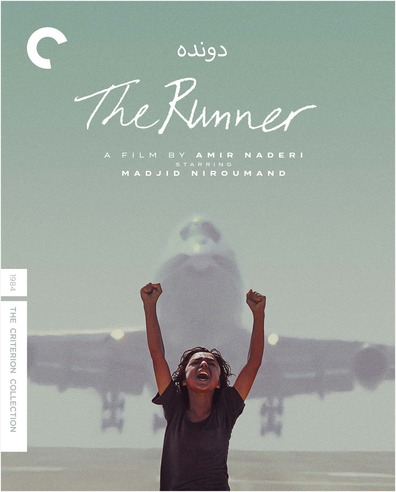
The Runner
Studio: The Criterion Collection
Mar 20, 2024
Web Exclusive
Photography by The Criterion Collection
![]()
Amir Naderi’s The Runner is a quiet, powerful and visually stunning depiction of childhood realities and dreams. The 1984 film is a masterwork of post-revolutionary Iranian cinema, introducing several cinematic techniques and thematic ideals that continue to play a large part in Iran’s incredible cinematic output.
The Runner follows Amiro (Madjid Niroumand), a young orphan living on a boat in a port city and working odd jobs–such as shoe shining, selling water or collecting empty bottles in the sea–in order to get by day-to-day. Between these jobs, he often follows the same routine. He hangs out with a group of young boys who constantly race and compete with one another to see who runs the fastest. He heads to the port, where he yells out at the boats, begging them to take him away to whatever lies beyond the sea. He goes to the town’s small airport, where he watches the property’s sole personal plane with awe–cheering when it flies over him or even at the mere sight of it on the tarmac.
While The Runner mainly opts for capturing moments of Amiro’s daily life rather than a strict and defined plotline, a small narrative runs throughout the film, particularly during its second half. Hoping to learn how to read, Amiro signs up for night school. Sequences of the child in school are rarely shown in the film. When they are, Naderi juxtaposes images of Amiro militantly rehearsing the Persian alphabet with those of him running around the port city. The prevalence of this contrast shows Amiro’s eagerness, both mentally and physically, to understand more of the world and its working elements.
It’s difficult to imagine a more fitting title for the film than The Runner, because shots of Amiro running around the city–both alone and with friends–are always at the film’s center, connecting all the story’s various threads together in a clear and concise fashion. The framing of running throughout the film helps communicate the theme of childhood joy, capturing the specific feeling of transcending your body as your legs keep moving, carrying you forward at a pace that isn’t ever tiring, but instead, fulfilling. In those moments, all of Amiro’s problems become muted as the character exhibits a sort of happiness that is nowhere else to be found in the film.
Thematically, the act of running also doubles as a representation of Amiro moving towards his future. The idea of growing up and transcending his current situation is always at the forefront of Amiro’s actions and personality. The film opens with several situations–whether that be Amiro yelling at the passing boats in the distance, or conversations with his friend about what lies beyond their field of vision–that reinforce the character’s desire to define his future and take control of his life. In this sense, the quick speeds at which Amiro runs can also be seen as a testament to the power of growing up, of defining your own path not only out of necessity, but out of genuine desire.
Another reason few films evoke the feeling of childhood quite like The Runner is because the film relies more on its visual language than strict dialogue. Naderi’s direction is sublime. Each shot–even those capturing theoretically drab places like boat ports or airports–is captivating and enveloping both in its own right and in relation to the rest of the film. Naderi is extremely talented at capturing the elements of life and contrasting them against one another. Scenes where the camera focuses on the murky water of the sea, vast fires or the airplane gliding through the air are impossible to look away from. The film’s reliance on visual language, again, doubles as a testament of the nature of childhood, where wonder and splendor exist in a way that words can never fully describe.
The Criterion Collection’s 2K digital restoration looks incredible, and the film’s physical release features a handful of featurettes that make it well worth a purchase. Among them: Waiting, one of Naderi’s short films (made before the revolution, in 1974), and a new conversation between Naderi and acclaimed Iranian filmmaker Ramin Bahrani (The White Tiger, 99 Homes). But, perhaps the most exciting thing about this release is that a film like this, so quiet in its process yet so profound in its revelations, can be spotlit for people to discover, adore and hopefully dive deeper into Iranian cinema as a result.
(https://www.criterion.com/films/34099-the-runner)
Current Issue

Issue #72
Apr 19, 2024 Issue #72 - The ‘90s Issue with The Cardigans and Thurston Moore
Most Recent
- 10 Best Songs of the Week: Nilüfer Yanya, Linn Koch-Emmery, Fat Dog, Crumb, St. Vincent, and More (News) —
- Fat Dog Announce New Album and Tour, Share Video for New Song “Running” (News) —
- The Obsessed, Howling Giant @ Brooklyn Meadows, NYC, April 12, 2024 (Review) —
- Premiere: Slow Joy Releases New Single and Video for “King Cowboy” (News) —
- Premiere: Mackenzie Shrieve Shares New Single “Didn’t I Tell Ya” Feat. Jane Bruce (News) —

Comments
Submit your comment
There are no comments for this entry yet.